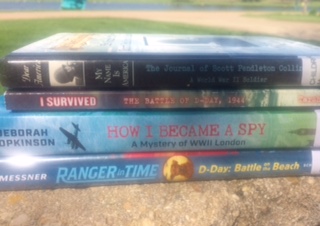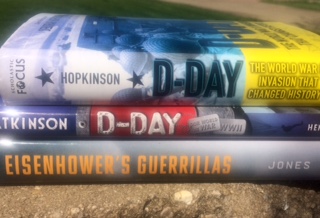As Americans commemorate Memorial Day, and as the 75th Anniversary of the D-Day Invasion of Normandy follows closely on June 6, here’s a list of books about D-Day where so many Americans, Allies, and French died for freedom.

D-Day books for younger readers:
Fiction:
D-Day: Battle on the Beach (Ranger in Time series) by Kate Messner (2018)—fiction—This novel features Ranger, the rescue dog, who time-travels back to June 6, 1944, to Normandy to save a Jewish boy and an African-American soldier. Messner handles the events and horror of WWII and D-Day in an appropriate way for readers of this chapter book, giving them facts and background info without overwhelming or traumatizing them.
How I Became a Spy: A Mystery of WWII London by Deborah Hopkinson (2019)—fiction—This middle grade novel features Bertie, a young London boy who volunteers for the Civil Defense, and Little Roo, his rescue dog, who find a notebook of a woman who may be a spy. The book is set several months before D-Day and shows what life was like for Londoners, as well as the Occupied French, and some of the tactics of the spies who helped the invasion succeed.
The Battle of D-Day, 1944 (I Survived series) by Lauren Tarshis (2019)—fiction—This chapter book focuses on a fictional French boy who lives near Omaha Beach in Normandy, rescues an Allied paratrooper, helps the French Resistance aid the Allied soldiers prior to and during the D-Day landing, and witnesses the horrific landing.
This book focuses on what life was like for the Occupied French, the Resistance, and the Jewish people, yet it portrays everything through the experience of an eleven-year-old boy who could’ve plausibly been at the invasion.

For young adults and adults:
Fiction:
The Journal of Scott Pendleton Collins: A World War II Soldier (A Dear America Book) by Walter Dean Meyers (1999)—fiction—This novel is written at a middle grade level, but since it focuses on a soldier’s experience from right before the D-Day landing on Omaha Beach through the next ten weeks of fighting in France, it’s level of violence and mild sexual content would be best for readers older than twelve.
Non-fiction:
D-Day: The World War II Invasion That Changed History by Deborah Hopkinson (2018)—non-fiction—This book contains about 300 pages of information about D-Day, including the necessity, the planning, the invasion itself, and the aftermath. It features the words of many of the participants. Hopkinson’s writing is interesting and she gives a very thorough overview, plus providing almost 70 pages in back matter.
I’d recommend it for readers ages twelve and up because it covers so many people and so many aspects of D-Day. It might be tough for a first introduction of D-Day to younger readers. Hopkinson does talk about the soldiers’ deaths and woundings, and there is much mention of blood and vomit, but she handles it in a sensitive way to keep the book from being overly graphic.
D-Day: The Invasion of Normandy, 1944 by Rick Atkinson and Kate Waters (2014)—This book is adapted for children from Atkinson’s book, The Guns at Last Light (that I haven’t read). D-Day gives a good overview of the planning and the actual landing, and it has a reading level for upper elementary readers and up, but like Hopkinson’s book it’s so full of information that it may be best for readers older than twelve. I even found myself overwhelmed in facts.
The Longest Day by Cornelius Ryan (1959)—I believe this non-fiction work was the groundbreaking work about D-Day. Historian Ryan used official records, but he also used information from hundreds of survivors—from the Allies, the Occupied French, and the Nazis.
On a personal note, when I read this book twenty some years ago, it wasn’t my first read about WWII, but I think it was my first one about D-Day. I remember finding it among my husband’s books, sitting on the floor to start reading it, and being captivated by the stories of the people who lived through the D-Day invasion.
Eisenhower’s Guerrillas: The Jedburghs, the Maquis, & the Liberation of France by Benjamin F. Jones (2016)—This scholarly work examines how the teams of Jedburghs, comprised of British, American, and Free French agents, worked together with the Maquis, also known as the French Resistance, to prepare for D-Day and it’s aftermath. Jones also discusses how the political situation between the leaders of America and the Free French affected the effectiveness of the guerrilla warfare by the Allies and French.
Band of Brothers: E Company, 506 Regiment, 101st Airborne From Normandy to Hitler’s Eagle’s Nest by Stephen E. Ambrose (1992)—I haven’t read this yet, but I’ve seen parts of the television mini-series based on this book and know that it brings D-Day and the rest of the liberation of Europe to horrifying life.
What books would you add to this list?
